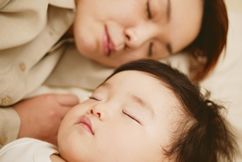A Letter to Doctors
The crib industry has gotten in bed with the CPSC to announce dramatically that 60 babies per year die from accidents in adult beds. They plan a large campaign to educate doctors and retailers about the supposed danger. One detail they seem to leave out is that a breastfeeding baby sleeping in an adult bed, made safe, next to their aware and protective, non-smoking mom, (co-sleeping), actually has a decrease in his risk of SIDS. Sleeping in a crib in another room of the house is the greatest risk factor for SIDS — 5 to 10 times the risk of sleeping in the same room as the parents.
Linda Folden Palmer, D.C.
Author The BABY BOND
Originally Published in the
International Chiropractic Pediatric Association
Newsletter July-August 2002
Updated November 26, 2003

Review of the Latest and Most-Authoritative Studies
 Cosleeping & SIDS Fact Sheet
Cosleeping & SIDS Fact Sheet
The Facts Against CPSC & JPMA Announcements
The crib industry has gotten in bed with the CPSC to announce dramatically that 60 babies per year die from accidents in adult beds. They plan a large campaign to educate doctors and retailers about the supposed danger. One detail they seem to leave out is that a breastfeeding baby sleeping in an adult bed, made safe, next to their aware and protective, non-smoking mom, (co-sleeping), actually has a decrease in his risk of SIDS. Sleeping in a crib in another room of the house is the greatest risk factor for SIDS — 5 to 10 times the risk of sleeping in the same room as the parents.
According to thier figures, the majority of these “adult bed” deaths occurred when babies were alone and unattended, and often on sofas, although the media has directed their attention toward co-sleeping in a family bed. The CPSC conclusion that no baby should ever be placed in an adult bed is in no one’s best interest (except that of the crib industry). Great fear is being imposed on families who would otherwise be choosing to co-sleep. The proper move is to recommend means to make adult beds safer.
Studies reveal that after leaving the womb there is an important continuum of mother-provided regulation. While asleep, parental warmth, heartbeat, and breathing help to regulate proper body temperature and oxygenation in baby. Co-sleeping also encourages natural breast feeding and comforting, adding important hormonal and immune regulation.
A century ago, as formula and other industry sales burgeoned, separate bedrooms for children became associated with images of affluence. However, a new problem arose — babies screaming from abandonment throughout the night. Solutions were now needed to encourage sleep in babies. Formula companies advertised that (difficult-to-digest) formula promotes longer sleep. Prone sleeping (an unnatural position for a baby nursing next to mom) was discovered to extend sleep. Allowing babies to cry for long periods induces deeper sleep states and has been endorsed as a positive practice. Today, nearly every early pediatric visit includes the question: “Is baby sleeping through the night?” — further encouraging the use of these unnatural sleep practices.
The problem here is this: long intervals of deep sleep are shown to be a major cause of SIDS. A co-sleeping baby naturally arouses frequently to lighter sleep states. On the other hand, prone positioning impinges the cervical spine and brain stem, and formula-feeding itself triples the SIDS rate.
Remember our mainly crib-sleeping, formula-feeding, U.S. infants with the highest medical attention in the world rank only 42nd (2003 statistic) in infant survival among reporting nations. Strong, dangerous messages from the formula and crib industries are being provided regularly to pediatricians. Parents should be free to make feeding and sleep choices that work best for their own family, but these choices should be made based on accurate information.

No Comments